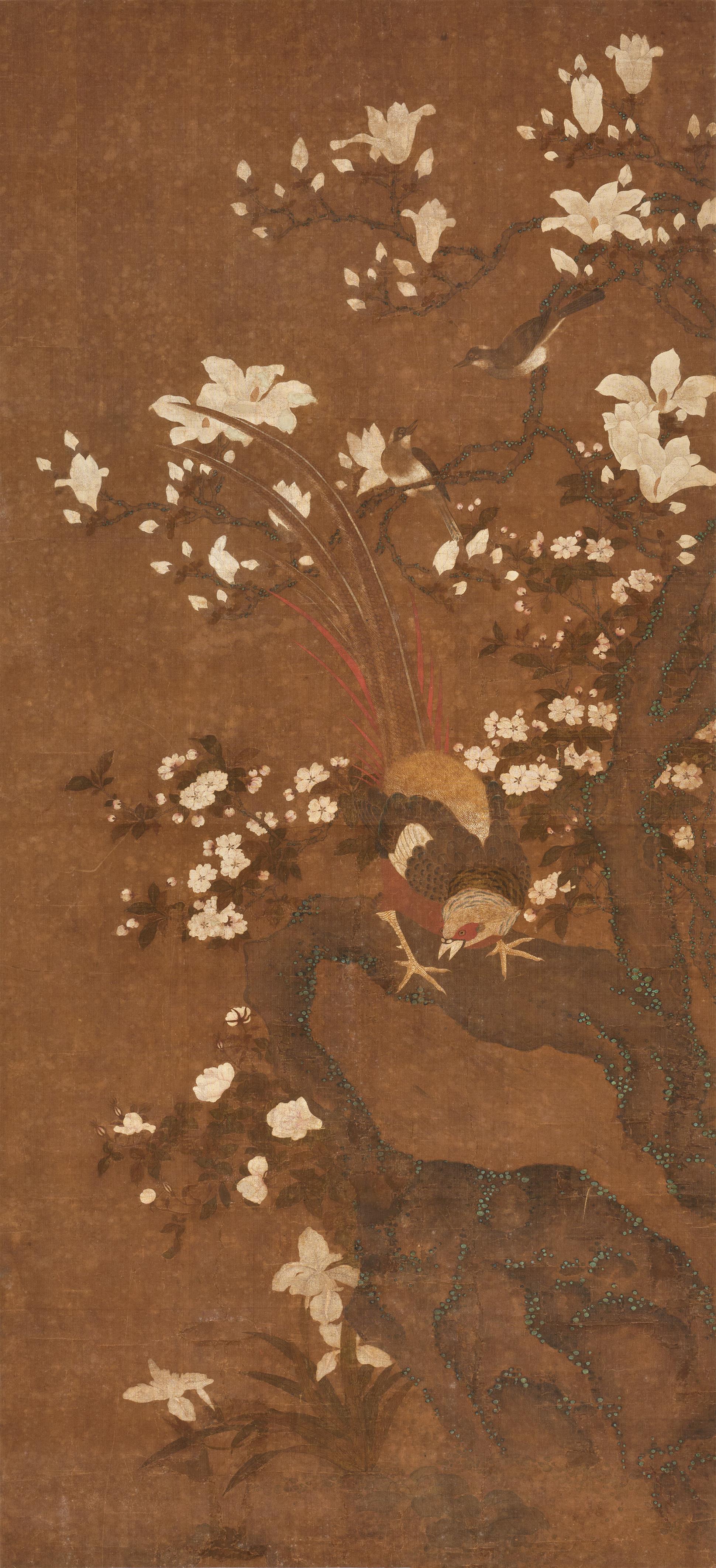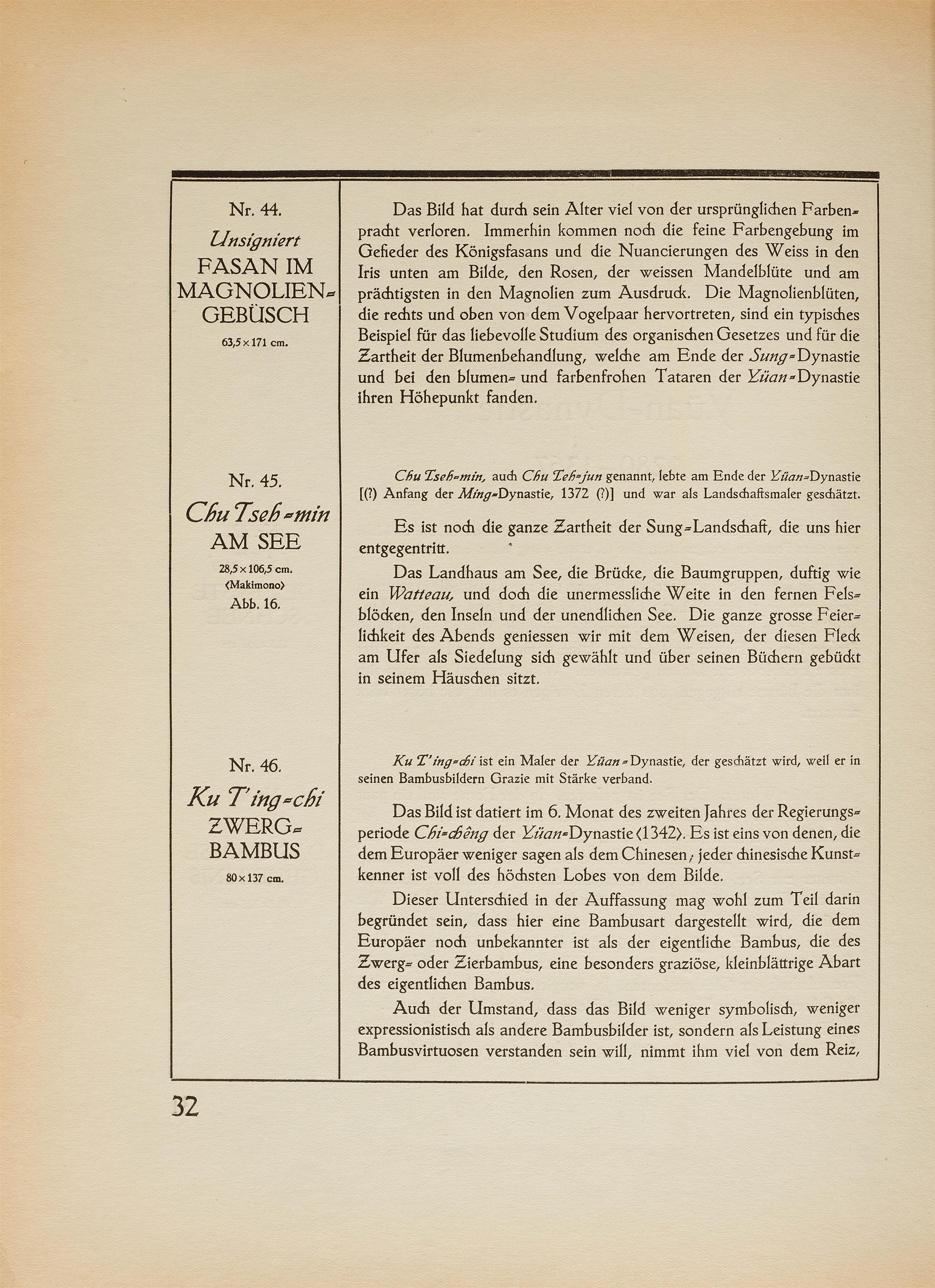Anonymous . Qing dynasty
A pheasant in a magnolia tree
Hanging scroll. Ink and colours on silk. The pheasant standing in a white flowering magnolia tree and surrounded by cherry blossoms and irises. The combination of the two magpies on a branch and numerous magnolia blossoms expresses an auspicious message. Restored.
159 x 73 cm
In East Asia, it is customary to attach a title strip (tiqian 題籤) on the outside of the additionally protective covering (baoshou 包首) of a hanging scroll parallel to the upper scroll bar (tiantou 天頭). The name of the artist and the subject of the picture, and perhaps other informations, are written on it.
This custom was adopted by Ernst Arthur Voretzsch. The German diplomat lived in a consular capacity in Hong Kong, Shanghai and Hankou from 1906 to 1916. During this time, he compiled his Chinese collection, which included a considerable number of paintings. Voretzsch usually glue his labels on top of the existing blank Chinese title slip. If this bore an inscription, he attached his own label next to the writing. In rare cases he pasted his label over the Chinese inscription, cut away the Chinese title slip, or attached his own title slip to the other end of the scroll.
The information was written on a typewriter in the rather rarely used cursive script or handwritten in Kurrent script in brown ink. Modified titles, artist's name and dates were added in pencil in the course of time. The Kurrent writing varies considerably, sometimes sloping, sometimes straight, and in some cases - for emphasis - the Latin cursive is used. Almost certainly it is always Voretzsch's handwriting.
These labels bear a variety of numbers. The most important is the marking "K." followed by a number. It refers to the catalogue number in the „Führer durch eine Ausstellung Chinesischer Gemälde“, a publication accompanying an exhibition at the Art Industry Museum (Kunstindustrimuseet) in Kristiania (now Oslo) in Norway in 1919. This exhibition featured only Chinese paintings including 139 hanging rolls, cross rolls, album leaves and fan paintings.
Other numbers on the title slips are 1) a one-digit number in a circle and 2) a low two-digit number in blue ink in a quartered adhesive label with a bluish-purple line border, 3) large numbers written in fat red pencil and 4) four-digit numbers in pencil. 1) and 2) probably date from the post-war period.
A label with a number is also occasionally pasted on the face of the hanging scroll knobs (zhoutou 軸頭). The printed number that appears on the knobs of lot 232 and 237 corresponds to the catalogue number of the „Führer durch eine Ausstellung Chinesischer Kunst aus der Sammlung Dr. E. A. Voretzsch", a publication accompanying an exhibition at the Museum für Kunst und Gewerbe in Hamburg in 1913. Here there are 235 catalogue entries on paintings (each the album leaf was also counted). Other numbers are in a round label with a printed ornamental blue border that was common in the pre-war period. These numbers could not be assigned.
Western collectors and art dealers have repeatedly written or attached information regarding the painting onto the back covering of a hanging scroll, but never to the extent as E. A. Voretzsch did. The large number of inscriptions, which date from different periods, and the six different numberings show how intensively Voretzsch occupied himself with his paintings over a period of five decades.
After his retirement, when he lived at Colmberg Castle from 1933 to 1965, he must have repeatedly drawn up lists to which the numerous other numbers refer. Here, a list of paintings for his Museum für Asiatische Kunst in Bamberg would come into question, and lists of the various sales offers after the museum was dissolved in 1959.
清 金雉木蘭圖
設色絹本 立軸
展覽: Dr. Ernst Arthur Voretzsch中國藝術收藏展, 漢堡工藝美術博物館,1913年; 中國繪畫藝術展, 藝術工業博物館,克裡斯蒂安尼亞 (奧斯陸),1919年
文獻: Dr. Ernst Arthur Voretzsch著,《中國藝術展覽指南》,漢堡工藝美術博物館,1913年,41頁,編號309; 《中國畫展覽指南》,克裏斯蒂安尼亞藝術工業博物館 (奧斯陸),1919年,32頁,編號44; E. A. Voretzsch 著,《支那畫》,東京,1932年,編號25
來源: 德國 Dr. Ernst Arthur Voretzsch(1868–1965) 私人收藏,此後由其家族傳承
外交官與亞洲藝術收藏家Ernst Arthur Voretzsch博士(1868-1965)的個人畫簽
歐內斯特·亞瑟·福雷奇博士(Ernst Arthur Voretzsch) 1906年到1916年以領事身份居住於香港、上海及漢口。在此期間,他整理了自己的中國藝術品收藏,其中包括相當數量的繪畫作品。通常情況下,福雷奇博士會將他自製的畫簽粘貼在空白的簽條上,如果簽條已有標注,他就把畫簽粘貼在其下方;極少數情況下,他會把自製的畫簽貼在原有的中文畫簽上面,把中文標注剪掉,或者把自己畫簽貼在卷軸的另一端。
這些畫簽上所使用的是一種比較少見的用打字机打出的斜體字或是棕色墨水手写的,到如今已经褪色库伦特体字。随着时间的推移,部分后添加的畫作标题、畫家姓名以及日期又用铅笔進行了補充。畫簽上库伦特字体是相当多样的,有时是斜的,有时是直的,在某些情况下,为了强调信息,畫簽還使用了拉丁文手寫體。據推測,這些都是福雷奇博士的笔迹。
福雷奇博士的畫簽上注有不同的數字標記,其中最重要的是標識符 "K."及其後面的數字。它指的是1919年在挪威,克里斯蒂安尼亞 (現奧斯陸 Oslo) 藝術工業博物館 (Kunst-Industriemuseum Kristiania) 舉辦的 "中國繪畫藝術展覽"中的目錄編號。該展覽展出了共計139幅掛軸、橫軸、冊頁和扇面畫。
畫簽上其他的編號有:1) 圓圈內的低位數字;2) 在一個四分之一的藍紫色邊框膠貼上用藍色墨水手寫的低位數字;3) 用粗紅鉛筆寫的數字;4) 用鉛筆寫的顯眼的4位數數字。1)和2)可能是戰後時期的標注。
軸頭表面偶爾也會有帶有編號的標簽。如拍品232和237軸頭正面黏貼的印刷標簽號碼與1913年在漢堡工藝美術博物館 (Hamburgisches Museum für Kunst und Gewerbe) 舉辦的" Ernst Arthur Voretzsch博士中國藝術收藏展覽"的目錄號碼相對應,此目錄中有235個關於繪畫的條目。其他的號碼則是在一個印有藍邊的圓形標簽中,這在戰前非常常見,但這些號碼的意義我們無從得知。
這些不同時期的畫簽和不同的編號顯示了福雷奇博士對這些畫作的重視和珍愛。他在漢堡及現在的奧斯陸向大衆展示了他的中國畫收藏,這一點可以從畫卷上的編號中得到證實。
Provenance
Collection Dr. Ernst Arthur Voretzsch (1868–1965), and thence by descent
Literature
Published in: Hamburgisches Museum für Kunst und Gewerbe, Führer durch eine Ausstellung aus der Sammlung von Dr. E. A. Voretzsch, Hamburg 1913, p. 41, no. 309 and in: Kunst-Industriemuseum Kristiania, Führer durch eine Ausstellung chinesischer Gemälde, [1919], p. 32, cat. no. 44 and in: E. A. Voretzsch, Chinese Pictures, Tokyo 1932, no. 25
Exhibitions
Ausstellung chinesischer Kunst aus der Sammlung von Dr. E. A. Voretzsch, Hamburgisches Museum für Kunst und Gewerbe, 5.10.–9.11.1913
Ausstellung chinesischer Gemälde, Kunst-Industriemuseum Kristiania, 1919




